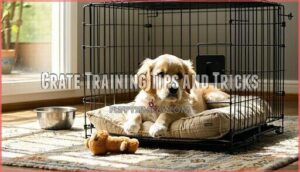This site is supported by our readers. We may earn a commission, at no cost to you, if you purchase through links.
 These 4 steps to crate train your dog will transform that wire cage into your pup’s personal sanctuary.
These 4 steps to crate train your dog will transform that wire cage into your pup’s personal sanctuary.
First, choose the right crate size—big enough for your dog to stand and turn around, but not so large they’ll treat one corner as a bathroom.
Second, introduce the crate gradually using treats and favorite toys to create positive associations.
Third, establish a consistent routine by feeding meals inside and practicing short sessions.
Table Of Contents
- Key Takeaways
- Choose The Right Crate
- Introduce Crate to Dog
- Establish Crate Routine
- Increase Crate Time Gradually
- Address Crate Training Challenges
- Crate Training Benefits
- Selecting Best Crate Location
- Crate Training Schedules
- Crate Training Tips and Tricks
- Crate Training Completion
- Frequently Asked Questions (FAQs)
- How to crate train a puppy?
- How long does it take to crate train a dog?
- How do I get my puppy to go into the crate?
- What is crate training for dogs?
- How do you teach a dog to crate?
- Should I crate train my new dog?
- What is the 2 1 rule for crate training?
- What is the 10 minute rule for crate training?
- What is a good crate training schedule?
- What to do if a puppy cries in a crate at night?
- Conclusion
Key Takeaways
- Choose the right crate size for your dog’s adult dimensions—big enough to stand and turn around, but not so large they’ll use one corner as a bathroom, and select materials based on your dog’s temperament and strength.
- Introduce the crate gradually using high-value treats and favorite toys to create positive associations, starting with 5-10 minute sessions and letting your dog explore naturally without forcing entry.
- Establish a consistent routine by feeding meals inside the crate and practicing short sessions 2-3 times daily, then gradually increase duration as your dog becomes comfortable.
- Address common challenges like whining and separation anxiety, and accidents with patience and strategic responses—ignore attention-seeking behavior but respond to genuine needs, and clean accidents immediately with enzyme-based solutions.
Choose The Right Crate
The right crate makes all the difference between successful training and a frustrated pup who refuses to cooperate.
You’ll need to take into account your dog’s size, breed, and preferences when choosing between wire, plastic, or soft-sided options that provide proper ventilation and security.
The perfect crate isn’t one-size-fits-all—it’s tailored to your dog’s unique needs and personality.
Consider Dog Size and Breed
Before selecting your dog crate, you’ll need to think ahead to your pup’s adult size rather than their current measurements. Large breed puppies grow rapidly, requiring significant space considerations.
Dog breeders often recommend crates with dividers to adjust as your pet grows. Growth considerations prevent costly replacements.
Breed temperament also matters – anxious dogs prefer enclosed spaces while confident breeds handle wire crates well. Selecting the right crate involves understanding appropriate crate dimensions, which is crucial for your dog’s comfort and adult size.
Material Options and Durability
Wire crates offer superior Metal Crate Durability with reinforced joints that withstand heavy use.
Plastic Crate Benefits include easy cleaning and weather resistance, making maintenance simple.
Consider Fabric Crate Portability for travel, though they’re less durable for strong dogs.
Wood Crate Aesthetics blend with home décor but require more upkeep.
Choose material based on your dog’s strength and your Cleaning Crate Materials preferences for long-term training success.
Proper crate size guarantees room to stand for long-term training.
Crate Types and Ventilation
You’ll find three main crate types for dog crate training, each offering different ventilation and security considerations.
Wire crates provide maximum airflow and visibility, perfect for dogs who don’t need enclosed spaces.
Plastic airline-style crates offer more security but less ventilation.
Soft-sided crates balance portability with moderate airflow, and many owners find great deals on various wire crate products.
Consider your dog’s anxiety level when choosing material breathability versus den-like comfort.
Introduce Crate to Dog
You’ll want to make your dog’s first crate experience calm and positive by placing the crate in a quiet area and letting them explore it naturally.
Start with short 5-10 minute sessions using high-value treats and favorite toys to create good associations before gradually increasing the time.
Start With Short Sessions
Once you’ve chosen your crate, begin crate training with brief 5-10 minute sessions.
This initial exposure helps your dog feel comfortable without overwhelming them. Keep a reward system ready and monitor behavior closely.
Practice these short sessions 2-3 times daily, focusing on positive experiences.
Remember, gradual increase in time prevents anxiety and builds confidence in your crate training puppy.
Use Treats and Toys
Treats work like magic during dog crate training.
Your dog’s crate becomes their personal sanctuary – a cozy retreat where anxiety melts away and comfort takes over.
Toss high-value treats inside to make the space irresistible.
Interactive toys keep your pup entertained and build positive crate associations.
Consider your dog’s toy preferences—some love squeaky toys while others prefer puzzle feeders.
Perfect your reward timing by giving treats the moment they enter.
Many owners find success using specific crate training treats.
Crate enrichment transforms training from struggle to success with the right approach and high-value treats, making it an essential part of crate training.
Create Positive Associations
When your dog approaches the crate calmly, reward them with treats to build positive association.
Place a KONG toy filled with their favorite snacks inside to encourage exploration.
During calm moments, let them discover the crate naturally—avoid forcing entry during playtime.
This treat association and toy introduction creates lasting positive memories.
Gradual increase in time spent near the crate strengthens their comfort level.
Establish Crate Routine
Once your dog feels comfortable in their crate, you’ll need to establish a consistent daily routine that makes crating a normal part of their schedule.
Start by feeding meals inside the crate, then gradually practice longer periods with the door closed to build their confidence and acceptance.
Feed Meals Inside Crate
Once your dog shows comfort exploring the crate, mealtime becomes your secret weapon for crate training success.
Food motivation naturally draws dogs into their space, creating positive associations with every bite. This feeding strategy builds trust and makes the crate feel like home base.
- Food Placement: Position the bowl at the back of the crate to encourage full entry
- Door Management: Keep the door open initially, then gradually close it during meals
- Mealtime Duration: Allow 15-20 minutes for eating before opening the door again
- Bowl Type: Use a heavy, non-tip bowl to prevent spills and maintain clean eating space
Practice Longer Crating Periods
Once your dog comfortably eats meals in their crate, you’ll need to gradually build their tolerance for longer stays.
Start with 30-minute sessions after meals, then slowly work up to 2-3 hours during daytime duration. This prepares them for overnight crating and extended absences while maintaining their comfort level.
| Time Period | Crate Duration | Activity |
|---|---|---|
| Week 1 | 30-60 minutes | Post-meal rest |
| Week 2 | 1-2 hours | Quiet household time |
| Week 3 | 2-4 hours | Weekend schedules |
The goal is to ensure your dog remains comfortable and secure in their crate, which is essential for their well-being and your peace of mind, allowing for extended absences.
Crate Dog When Leaving Home
Once your dog handles longer crating periods comfortably, it’s time to start leaving home.
This step teaches independence and prevents separation anxiety from developing. Start with very short trips to build confidence gradually.
Here’s how to crate your dog when leaving home:
- Establish a pre-crate routine – Give your dog a potty break and place a special toy inside before departure
- Start with 15-minute trips – Begin with quick errands to test your dog’s comfort level with being alone
- Ignore post-arrival behavior – Don’t make a big fuss when returning to avoid creating excitement around your departures
Increase Crate Time Gradually
Once your dog accepts the crate for short periods, you’ll need to slowly extend the time they spend inside.
Start with brief 10-15 minute sessions and add a few minutes each day, watching how your dog responds to make certain they stay comfortable and relaxed.
Begin With Short Periods
Starting with five-to-ten minute sessions sets the foundation for successful crate training.
Keep these initial periods short and positive, using treats and calm introductions to reduce anxiety. Your puppy needs time to adjust without feeling overwhelmed.
Focus on positive reinforcement during each session, making the crate a welcoming space. This gradual training approach builds confidence naturally.
Gradually Increase Time
Building on your success, extend your crate training time by adding five to ten minutes each session.
Watch how your dog responds during these longer durations – tail wagging and calm behavior signal you’re on track.
Avoid rushing the gradual progression, as positive reinforcement works best when paired with patience.
Each successful session length prepares your pup for the next milestone.
Monitor Dog’s Behavior and Adjust
Watch for anxiety signs like excessive panting, drooling, or scratching at the crate door. If you notice training regression or your dog seems uncomfortable, adjust your schedule immediately.
Reduce crate time and rebuild positive associations slowly. Monitor crate training behavior closely during each session.
Don’t hesitate to seek help from a professional trainer if troubleshooting common issues doesn’t improve your dog’s crate comfort and training progress.
Address Crate Training Challenges
Even the most patient dog owners encounter challenges during crate training, from persistent whining to separation anxiety.
You’ll need specific strategies to address these common issues while maintaining your dog’s positive association with the crate.
Separation Anxiety and Solutions
Recognize that separation anxiety affects 14-20% of dogs during crate training.
Start with gradual desensitization by practicing short departures. Use calming techniques like puzzle toys and pheromone diffusers.
If your dog shows persistent destructive behavior or excessive stress, consider professional help. Medication options from your vet can support anxiety prevention alongside consistent training routines.
Whining and Howling Strategies
Your dog’s whining and howling during crate training requires strategic responses. Ignore attention-seeking vocalizations but respond to genuine potty break needs.
Provide mental stimulation toys inside the crate and guarantee adequate exercise beforehand to reduce restless behavior.
If persistent whining continues despite consistent training efforts, professional consultation can address complex vocalization challenges and improve your crate training troubleshooting success.
Accidents and Cleaning
Accidents happen during crate training, but quick action prevents lasting damage.
Clean pee immediately with enzyme-based cleaning solutions for complete odor removal. Place puppy pads temporarily if accidents persist, though this may slow progress.
Proper crate sanitation eliminates smells that encourage repeat incidents.
Address stain prevention by monitoring your dog’s schedule and adjusting crate time accordingly to minimize these common dog crate problems, ensuring a clean and safe environment for proper crate training.
Crate Training Benefits
You’ll find that proper crate training creates a secure space where your dog can relax while preventing destructive behaviors like chewing furniture or having accidents indoors.
This method also speeds up housebreaking and reduces your dog’s anxiety by giving them a den-like retreat they can call their own, which is a key aspect of crate training.
Housebreaking and Reduced Anxiety
Crate training creates a powerful one-two punch for your dog’s wellbeing.
Your pup’s natural instinct to avoid soiling their sleeping area makes potty training 40-60% faster than traditional methods. Meanwhile, that cozy crate becomes their safe haven, dramatically reducing anxiety levels and behavioral issues.
- Accelerated housebreaking – Dogs naturally keep their den clean
- Anxiety reduction – Predictable routines lower stress hormones
- Comfort levels – Secure space promotes emotional stability
Prevention of Destructive Behavior
Your crate prevents costly furniture damage and saves your favorite shoes from becoming chew toys. When dogs get bored or anxious, they’ll destroy whatever’s within reach.
Crate training solutions include providing mental stimulation toys and ensuring adequate exercise before crating. This containment stops undesirable behaviors like digging through trash or scratching doors.
Proper crate training troubleshooting addresses these destructive tendencies effectively. For breeds like Weimaraners, crate training benefits include reducing separation anxiety.
Your crate is essential for crate training, which helps prevent damage and saves your belongings from becoming chew toys. Proper crate training solutions can make a significant difference in your dog’s behavior.
Safe Space for Dogs
Beyond stopping unwanted chewing and scratching, your dog’s crate becomes their personal sanctuary.
Think of it as their bedroom where they can retreat when overwhelmed. This secure haven taps into their natural den instinct, providing crate comfort that reduces anxiety in busy households.
- Anxiety reduction through familiar, enclosed spaces
- Calming tool during thunderstorms or fireworks
- Safe space away from children or other pets
- Secure haven for rest and recovery
Selecting Best Crate Location
You’ll want to place your dog’s crate in a central area where your family spends time, like the living room, to prevent isolation and anxiety.
Start with a high-activity room during the day, then consider moving it to your bedroom at night if your dog struggles with being alone.
High-Activity Room or Bedroom
Your initial crate placement sets the foundation for successful crate training.
Choose between a high-activity room where your family gathers or your bedroom for prime results.
Both locations offer distinct advantages for puppy crate training and help with anxiety reduction through owner proximity.
| Location | Advantages | Disadvantages | Best For | When to Use |
|---|---|---|---|---|
| High-Activity Room | Social integration, reduces isolation anxiety | More distractions, harder to sleep | Daytime training, social dogs | Initial crate training introduction |
| Bedroom | Owner proximity, comfort prioritization | Limited space, potential sleep disruption | Nighttime, anxious puppies | Separation anxiety cases |
| Kitchen | Easy cleanup, meal associations | High traffic, food distractions | Feeding schedules | Mealtime crate sessions |
| Living Room | Family bonding, constant supervision | Noise levels, overstimulation | Active households | Gradual location shift |
| Quiet Corner | Peaceful environment, less stimulation | Isolation feelings, reduced monitoring | Calm dogs, final placement | Advanced crate training stages |
The choice of location depends on the specific needs of your puppy, including factors such as social integration, owner proximity, and the need to reduce isolation anxiety or separation anxiety.
The table provides a summary of the advantages and disadvantages of each location, helping you decide the best place for your puppy’s crate based on your lifestyle and the puppy’s individual needs, ensuring an effective crate training process.
Consider Dog’s Preferences
Your dog’s personality matters when placing their dog crate.
Some dogs prefer quiet corners while others want to watch household activity. Watch for anxiety levels during gradual introduction and respect their den preference naturally.
- Observe comfort items your dog gravitates toward – blankets, toys, or specific sleeping spots
- Notice breed tendencies like herding dogs wanting visibility or hounds preferring enclosed spaces
- Test different locations using dog crate training methods to find their sweet spot
Adjust Location as Needed
Ideal placement isn’t set in stone.
You’ll need to move your dog’s crate as training progresses.
Start with room relocation from high-traffic areas to quieter spaces once your pup adapts.
Monitor dog comfort levels during gradual relocation.
If you notice increased whining or resistance, slow down the process.
Minimize isolation by keeping the crate accessible until your dog masters independence.
Crate Training Schedules
You’ll need a clear timeline to make crate training work without overwhelming your dog.
Following a structured schedule from days 3-11 helps your dog adjust gradually while building positive associations with their new space.
Days 3-6 Feeding and Crating
Now that you’ve found the perfect spot for your crate, it’s time to make meals work their magic.
During days 3-6, feeding becomes your secret weapon for crate training success. Start with Mealtime Association by placing your dog’s bowl near the crate, then gradually move it inside.
- Practice Gradual Food Placement by moving the bowl deeper into the crate each day
- Use Door Closing Practice during meals, starting with just a few seconds
- Build Crate Proximity comfort through consistent Positive Reinforcement and treats
This crate training feeding approach transforms the crate training process into something your dog anticipates rather than fears, using Gradual Food Placement and Crate Proximity to achieve success.
Days 7-11 Nap Time and Alone Time
By week two, your pup’s ready for structured naptime sessions and solo crate time.
Schedule 1-2 hour naps between meals, creating cozy crate comfort with soft blankets.
Start with 15-minute alone periods, then practice gradual increase to 30 minutes daily.
Monitor behavior closely—whining’s normal, but destructive scratching isn’t.
This crate training process builds independence while maintaining positive associations, which is crucial for the pup’s development, and it helps to prevent issues like destructive scratching.
Crate Training Tips and Tricks
Successfully crate training your dog requires consistent daily practice and positive reinforcement techniques that build trust over time.
You’ll need patience to troubleshoot common issues like whining or resistance, but these proven strategies will help you overcome obstacles and create a safe, comfortable space your dog actually enjoys.
Consistency and Patience
Success with crate training consistency and crate training patience requires avoiding rushing through the process.
Your crate training guide should emphasize gradual progression over quick fixes.
Managing expectations helps prevent frustration when your dog needs extra time.
This long-term commitment means sticking to your routine even when progress feels slow.
Remember, every dog learns differently, so maintain your crate training tips consistently, and this will require crate training patience.
Positive Reinforcement Techniques
Reward timing makes or breaks your crate training success. Deliver treats within 1-2 seconds of your dog entering the crate to maximize positive associations. Combine verbal praise with high-value treats like chicken or cheese for stronger reinforcement.
Clicker training provides precise behavior shaping by marking exact moments of correct actions. Operant conditioning fundamentals play a key role in this process.
- Treat variety prevents boredom – rotating between chicken, cheese, and special training treats keeps your dog motivated
- Immediate rewards create lasting memories – that split-second timing transforms crate entries into exciting experiences
- Verbal praise amplifies success – your enthusiastic "good crate!" becomes music to their ears
Troubleshooting Common Issues
Most crate training problems stem from rushing the process or negative associations.
When your dog shows crate refusal, anxiety barking, or destructive behavior, step back and slow down.
Address crate training whining by ignoring attention-seeking sounds but responding to genuine potty needs.
Clean accidents thoroughly and make certain proper crate sizing to prevent chewing escape attempts, addressing potential issues with crate refusal.
Crate Training Completion
You’ll know your crate training is complete when your dog enters willingly and stays calm for extended periods without whining or scratching.
Once your dog shows these signs of readiness, you can gradually phase them out of the crate while maintaining the good habits you’ve established.
Transitioning Out of Crate
Your dog’s ready to graduate from their cozy den.
Start with supervised freedom in one room for 30 minutes, then gradually extend time.
The freedom timeline varies by dog, but most handle overnight freedom after consistent success.
Begin crate training weaning by removing the door first, then the entire crate once they’ve mastered longer durations without accidents, which leads to consistent success.
Signs of Readiness
When your pup shows consistent calm behavior and reduced anxiety around their crate, you’re seeing real crate training progress.
A potty trained dog with relaxed posture signals readiness for more freedom.
Watch for these signs of crate training tolerance:
- Independent play without whining or scratching
- Enters willingly when you give the crate command
- Sleeps peacefully through the night without accidents
- Remains calm when you leave the house
- Shows no destructive behavior when unsupervised
Maintaining Good Habits
Keep up consistent reinforcement even after your dog masters crate training.
Offer periodic refreshers with treats and praise to prevent habit regression.
Practice crate commands weekly to maintain sharp responses.
This habit generalization guarantees long-term benefits stick around.
Monitor your crate training progress regularly and adjust your crate training management approach.
Consistent crate training troubleshooting keeps skills fresh for life.
Consider crate training benefits for long-term success.
Frequently Asked Questions (FAQs)
How to crate train a puppy?
Start by placing treats inside the crate, letting your puppy explore freely.
Feed meals inside, gradually closing the door.
Increase time slowly from minutes to hours, and use positive reinforcement, never punishment.
How long does it take to crate train a dog?
Most dogs learn crate training within two weeks with consistent practice.
Some adjust in just a few days, while others need up to a month.
Your patience and daily routine determine success more than your dog’s age.
How do I get my puppy to go into the crate?
Use high-value treats to lure your puppy inside the crate.
Toss treats toward the back, letting them explore freely.
Never force entry. Practice the "crate" command with rewards until they associate it positively.
What is crate training for dogs?
Think of it as your dog’s personal bedroom retreat.
Crate training teaches your pup to see their crate as a safe, comfortable space for rest, sleep, and downtime.
While helping with housebreaking and preventing destructive behaviors.
How do you teach a dog to crate?
Introduce the crate gradually with treats and toys to create positive associations.
Feed meals inside, then slowly increase time with the door closed.
Practice short sessions daily, rewarding calm behavior consistently.
Should I crate train my new dog?
Yes, you should crate train your new dog.
It provides a safe haven, accelerates housebreaking, and prevents destructive behavior.
Most dogs learn to love their crate within two weeks with consistent, positive training.
What is the 2 1 rule for crate training?
Think of crate training like building a house – you need a solid foundation.
The 2:1 rule means your dog can stay crated for two hours maximum for every one month of age, helping prevent accidents and anxiety.
What is the 10 minute rule for crate training?
The 10-minute rule means starting crate training with short 10-minute sessions, then gradually increasing duration.
You’ll begin with brief, positive exposures to build your dog’s comfort and confidence before extending crate time longer, using the 10-minute rule as a guideline.
What is a good crate training schedule?
Here’s the secret to successful crate training: start with short 10-minute sessions, gradually increasing time over two weeks.
Feed meals inside, practice daytime naps, then progress to overnight stays once they’re comfortable with short sessions and gradually increasing time.
What to do if a puppy cries in a crate at night?
Stay calm and resist rushing to comfort your crying puppy.
Ignore attention-seeking whining, but take them out for potty breaks if needed.
Place the crate near your bed initially for comfort.
Conclusion
Success transforms your wire cage into your dog’s beloved retreat when you follow these 4 steps to crate train your dog consistently.
Remember that patience beats speed every time—rushing the process often creates setbacks.
Your pup will signal readiness by entering willingly and resting peacefully inside.
Once you’ve mastered proper sizing, positive associations, routine establishment, and gradual time increases, you’ll have created a safe haven that benefits both you and your furry companion for years ahead.




















